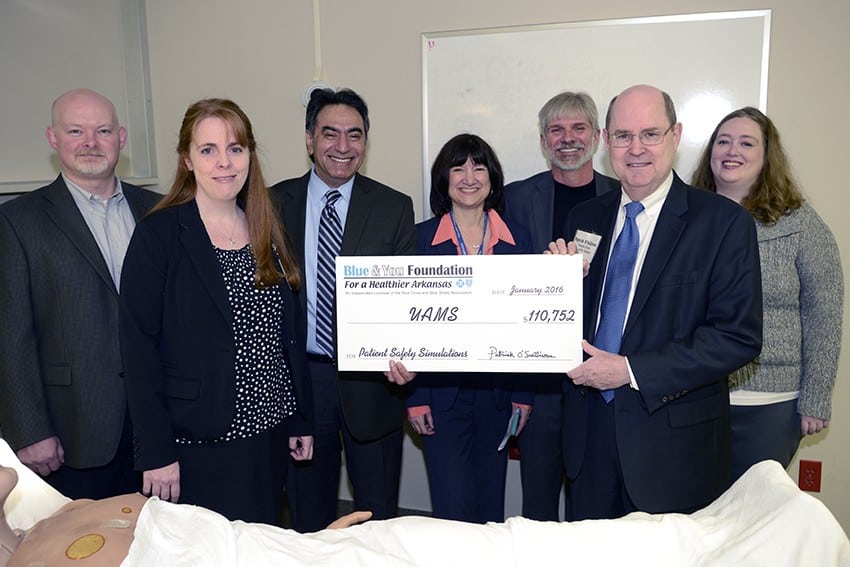Blue & You Grant to Fund Patient Safety Outreach Program
| Jan. 19, 2016 | Improving patient safety is at the heart of the Simulation Outreach to Address Patient Safety (SOAPS) project.
The Blue & You Foundation awarded UAMS $110,752 to the one-year simulation education outreach project, which is led by Muhammad Jaffar, M.D., the principal investigator and a professor in the College of Medicine’s Department of Anesthesiology; Miranda Morris, assistant director of the Office of Continuing Medical Education and director of education and quality initiatives in CE and Michael Anders, Ph.D., director of education and research in the Centers for Simulation Education.
At a check presentation Jan. 8 in the Simulation Center, Blue & You Foundation Executive Director Patrick O’Sullivan praised the SOAPS program and noted that its focus on patient safety was a key factor in UAMS receiving the grant.
“The issue of patient safety is important to health care in Arkansas, so anything that can advance that cause and help teach professionals about patient safety was an important factor in our selection,” he said.
Provost Stephanie Gardner, Pharm.D., Ed.D., thanked O’Sullivan for the grant and noted that over the past 14 years, the Blue & You Foundation has awarded UAMS more than $2.6 million in funding, making it a member of the Double Helix Society. The Blue & You Foundation was established in 2001 by Arkansas Blue Cross and Blue Shield to support health-improvement programs in Arkansas.
Partnering with UAMS on the project are the Arkansas Department of Health and the Greater Delta Alliance for Health, as well as the two hospitals receiving the training, Jefferson Regional Medical Center in Pine Bluff and Chicot Memorial Medical Center in Lake Village.
“As the state’s only academic health institution, one of our key responsibilities is to spread the word about best practices and to help other institutions improve the quality of care,” said Jaffar. “This grant from the Blue & You Foundation helps us to accomplish that.”
The project targets three conditions — central line associated bloodstream infections (CLABSI), catheter-associated urinary tract infections (CAUTI) and sepsis. The first two are health care-associated infections that can lead to sepsis.
Morris said there were several reasons why the researchers chose CAUTI and CLABSI to address, including the cost of treatment and the penalties leveled by the Centers for Medicare and Medicaid Services against hospitals that exceed certain rates of the two infections.
“The other reason is these types of infections are generally preventable,” she said. “There are well-established best practices that a lot of people don’t use. Many of those infection prevention practices are easy to teach and easy to learn.”
Sepsis, which is a rapid-onset, life-threatening systemic response to infection, is the most expensive condition treated in U.S. hospitals, and the estimated annual cost of treating sepsis in Arkansas is around $200 million, the investigators said.
Anders noted that sepsis is tricky to diagnose and is often missed. The SOAPS program will teach new sepsis diagnosis guidelines that are being issued by the Society for Critical Care Medicine in February.
Despite the enormous cost of treating sepsis and the difficulties in diagnosing it, Arkansas doesn’t have a statewide sepsis network, something Jaffar would like to remedy.
The SOAPS project will employ web-based learning modules and hands-on simulation training for approximately 125 health care professionals at Jefferson Regional and Chicot Memorial.
Anders said he is working with the two hospitals to tailor the simulation training for each institution and its employees. The simulation training will take place at each facility.
The final aspect of SOAPS will involve working with personnel at each hospital to prepare them to be able to conduct their own trainings and data collection so that the program can continue without the UAMS team being present.
“This program takes simulation education out into the community hospitals to really make a direct impact on patient outcomes, Gardner said, calling the project with its mix of clinical service, education and outcomes research “a perfect example of what UAMS is about.”
